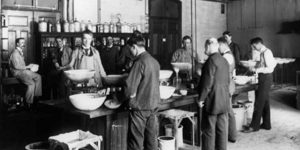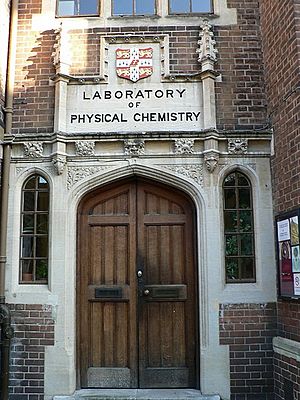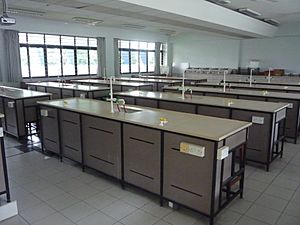Chemical education facts for kids
Chemistry education is all about how we teach and learn chemistry. It looks at how students understand chemistry and the best ways to help them learn. People who study chemistry education, called researchers, work to make learning better. They do this by finding new teaching methods and helping chemistry teachers get good training.
Researchers look at many ways of teaching. These include classroom talks, showing experiments, and hands-on lab activities.
There are not enough chemistry teachers around the world. This is because people with science skills can often find jobs that pay more money outside of teaching. It can be hard to keep science teachers in schools. For example, over 45,000 math and science teachers left teaching in the United States after the 1999–2000 school year.
Contents
What is Chemistry Education About?
There are a few ways to think about chemistry education.
Teachers in Action
One way is to look at what teachers actually do. The people who teach chemistry show us what chemistry education is by how they teach in their classrooms and labs. This is called a practitioner’s perspective.
Focusing on Teaching Chemistry
Another way is through a group of people called chemical educators. These are teachers and professors who focus mainly on teaching chemistry, not just doing chemistry research.
Some people wonder why we need a special name like "chemical educator." They ask why we don't just call them "chemistry professors." One reason is that many chemistry professors don't have special training in how to teach. They might not know the best ways to help students learn. They might not know about different teaching methods that work well.
Researching How We Learn Chemistry
A third way to think about chemistry education is through chemical education research (CER). This is like physics education research (PER). CER uses ideas and methods from science education research to understand how students learn chemistry in college and high school.
CER also tries to make chemistry teaching better for younger students. Researchers in CER usually study how other teachers teach. They don't just focus on their own classrooms.
Chemical education research often happens in real schools and colleges. Researchers collect different kinds of information.
- Quantitative methods mean collecting numbers and data. This data can then be studied using math and statistics.
- Qualitative methods mean collecting information that isn't numbers. This can include talking to students in interviews, watching how classes are taught, or reading what students write in journals. These methods are common in social science research.
Images for kids
-
Children mix chemicals in test tubes as part of a hands-on chemistry education program in Samara, Russia.
See also
 In Spanish: Educación química para niños
In Spanish: Educación química para niños





